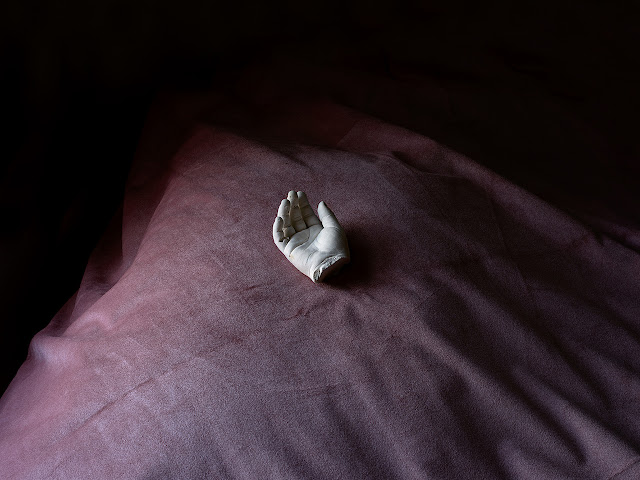 |
Who is Changed and Who is Dead. By Ahndraya Parlato.
|
Photographs by Ahndraya Parlato
Mack, London, UK, 2021. 128 pp., 6¾x9".
Sometimes it is hard to extricate pain from pleasure, as I wrote some months ago in a review of Wei Weng’s Eat a Chili. We balance the allure of a gleaming hook with the subsequent pain of a bite. Some books punch me with one unforgettable image, others pace their strikes. Ahndraya Parlato's new book slowly caresses, and gently twists its knife, through text and image alike. I find that I cannot turn away, or do not want to.
Who is Changed and Who is Dead is a book of lucid photographs, interspersed with evocative writing. It is also a book of lucid writing, interspersed with evocative photographs. The pacing, of both, is unfaltering. Parlato’s autobiographical writing, succinct and matter of fact, describes a messy and utterly devastating personal narrative. Spoiler alert: there is significant trauma, a suicide, and a murder. She maintains a tone, with text and photographs alike, that is contemplative while impassive, conversational and occasionally playful.
Part I is written to Parlato’s two daughters. She describes the singular paranoia of parenting: Can I protect my children? From abduction by strangers, imaginary wolves skulking in our bathrooms, school lockdown drills or the overt sexualization of their young gendered bodies. Or, Can I protect myself, as a parent? From the horror of not being able to shield them from any of this.
 |
Certain snippets pierce me, as the knife embeds, twists. She compares parents to amateur ceramic vessels — clunky, poorly formed and painted, we try our best to simply hold water. Photographs of a material collection of such vessels (mugs, ewers, some still with thrift store price tag affixed) form one of multiple intertwined visual motifs. Two vases and a pitcher teeter on her daughter’s back, a red sweep in the background cradling all.
The photographs are as careful and succinct as the text. Rich and velvety, they carry a warmth that the text often belies. Fittingly, there is a lot of red. Red of violence, red of warmth, red of maternal bloodshed — the latter in implication, at least — as both routine and not. Sheets as backdrops of play, sheets as shrouds. Cut flowers, days past when they should have met the compost pile, echo our mortality (as well as my own neglected table).
 |
 |
Color photograms of the cremated remains of Parlato’s mother are interspersed throughout the book. Printed on a glossy, seductive paper, they interrupt the matte surface of the other pages. Part II is written to her mother, posthumously, and the reader shifts from inhabiting the space of two daughters to that of a parent figure. We read of a long history of mental illness, and the author’s navigation of caretaking, straddling a line between love and annoyance. She speculates on how much we manage to infuriate our mothers, and how exasperating we find our own mothers, in turn.
Who is changed, and who is dead? Parlato’s vivid photographs remind us that we live our own metamorphoses and mortalities through a mundane intermingling of angst and elation, tautness and slackness, growth and stagnation. Mirroring imperfectly formed ceramic vessels, we simply try to hold water, to tread water. Like Parlato, running is my own outlet through it all: I run to navigate motherhood, I run to navigate daughterhood. Running and mothering, running and daughtering. What we run from, and what we run toward, are at the core of this dazzling book.
Purchase Book
Read More Book Reviews
 |
 |
 |









